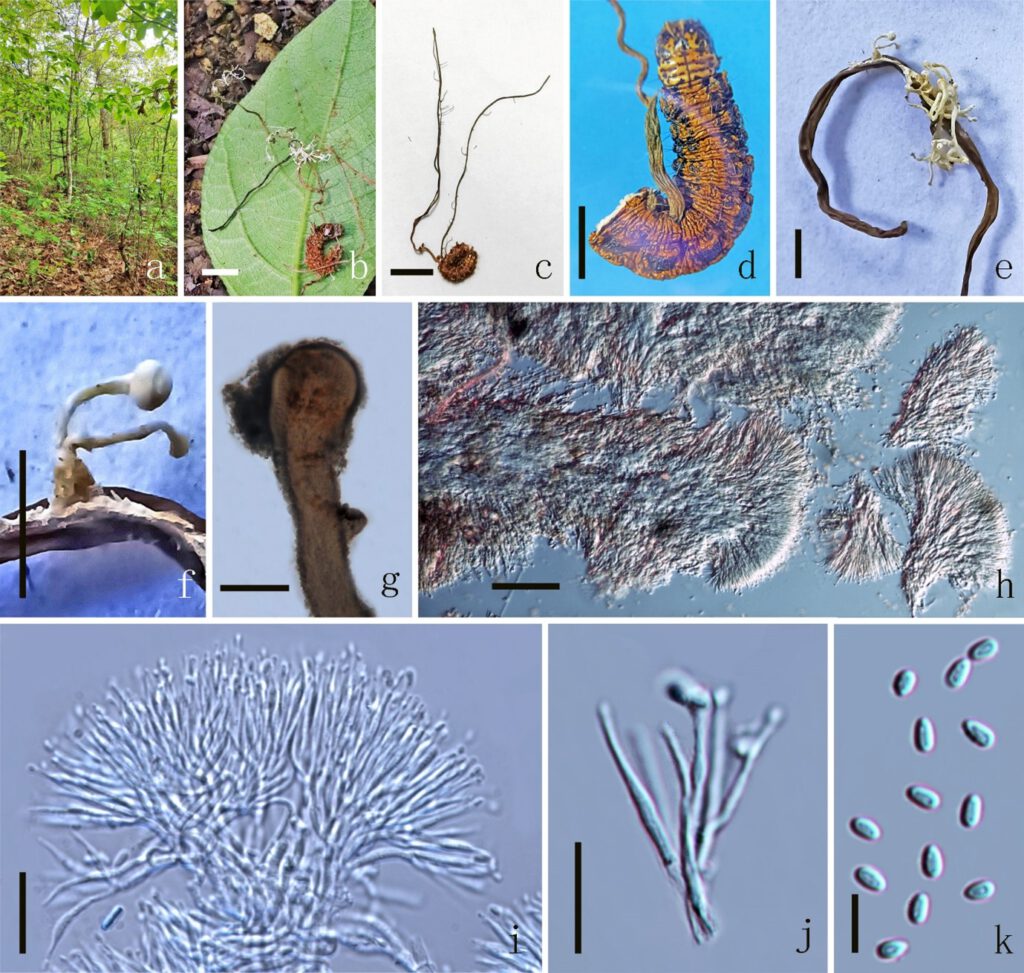Polycephalomyces formosus Kobayasi, Sci. Rep. Tokyo Bunrika Daig., Sect. B 5: 245 (1941). Fig. 6
MycoBank number: MB 289806; Index Fungorum number: IF 289806; Facesoffungi number: FoF 10731;
Host: Ophiocordyceps multibrachiata
Parasitism on the Ophiocordyceps multibrachiata (See Fig. 8). Sexual morph: Undetermined. Asexual morph: Hyphomycetes. Synnemata 1–10 mm long, 0.1–0.3 mm wide, scattered or gathered on the stipe of Ophiocordyceps multibrachiata, stipitate, solitary or forming 2–3 branches, white to pale yellow, cylindrical or rhizoid with or without an enlarged globose fertile head on the top. Fertile head 0.1–0.3 mm wide, globose to subglobose, white to pale yellow, coved with masses conidia. Stipe 1–10 mm long, 0.1–0.2 mm wide, cylindrical or rhizoid, white. Conidiophore 28–66 µm long ( = 47 µm, n = 60), concentrated in the fertile head, monothetic and solitary or acropleurogenous in the whorls, 1–4 phialides in one. Phialides 26–46 × 0.5–1.8 µm ( = 36 × 1.2 µm, n = 60), tapering gradually from middle to the apex, narrowly cylindrical to subulate, 1–1.8 µm wide at the base and 0.5–0.9 µm wide at the apex, one-type, hyaline, smooth, forming a hymenial layer. Conidia 2–4 × 1–1.5 µm ( = 3 × 1.2 µm, n = 60), 1-celled, one-type, hyaline, oblong ellipsoid to obovoid.
Material examined: China, Guizhou Province, Zunyi City. Parasitic on Ophiocordyceps multibrachiata on Lepidoptera in the soil, 22 October 2020, Qingfeng Meng, WFKQ03-20102201, (GZU 21–WFKQ03, KSH 21–WFKQ04, new records).
Notes: The new collections clustered with other Po. formosus sequences in the same clade with maximum statistical support in all cases (Figs 2-4). The morphology of the new collections is similar to Po. formosus. Thus, a new record is proposed for the type species Po. formosus in China.

Fig. 6. Polycephalomyces formosus (New record–: GZU 21–WFKQ03) a Habitat of Polycephalomyces formosus. b Synnemata emerging from infected Ophiocordyceps multibrachiata. c Overview of Ophiocordyceps multibrachiata. d Host of Ophiocordyceps multibrachiata. e, f Synnemata. g, h Vertical section of synnemata. i Conidiophores. j Philidies. k Conidia. Scale Bars: b, c = 1 cm, d–f = 5000 µm, g = 200 µm, h = 50 µm, i, j = 20 µm, k = 5 µm.
